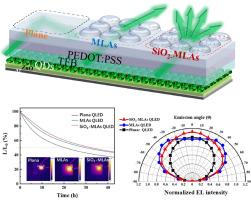利用米氏散射微透镜阵列增强量子点发光二极管的全角光外耦合能力
IF 3.3
3区 物理与天体物理
Q2 OPTICS
引用次数: 0
摘要
高效率、高亮度和长寿命的量子点发光二极管(QLED)对于实现集成显示和照明应用至关重要。然而,约有 80% 的光通过衬底模式、波导模式和等离子模式被限制在器件内部,这大大削弱了器件的亮度、效率和寿命。在这里,通过液滴在衬底表面的自发凝结,制造出了大面积的准周期凹模板。在准周期模板的基础上,通过在二氧化硅纳米球薄膜上压印,制备了二氧化硅微透镜阵列(SiO2-MLAs)米氏散射复合结构,显著改善了全角度的光外耦合,优化了准朗伯发光特性。与最先进的平面 QLED 相比,外部量子效率(EQE)有了质的提高(20%)。因此,采用 SiO2-MLAs 结构的绿色 QLED 的 EQE、亮度 (L)、T50 寿命(亮度减半)分别优化了 22%、28%、31%,最高可达 24.21%、381962.6 cd/m2、111335 h。这一策略为量产和利用 SiO2-MLA Mie 散射复合结构提高 QLED 在高效显示和照明应用中的性能提供了宝贵的见解。本文章由计算机程序翻译,如有差异,请以英文原文为准。

Full-angle light out-coupling enhancement of quantum dot light-emitting diodes by Mie-scattering micro-lens arrays
High efficiency, high brightness, and long-life quantum dot light-emitting diodes (QLEDs) are crucial for realizing integrated display and lighting applications. However, about 80% of the light is confined inside the device with substrate mode, waveguide mode, and plasma mode, which greatly weakens the brightness, efficiency and lifetime of the device. Here, a quasi-periodic concave template with large area was fabricated through the spontaneous condensation of droplets on the substrate surface. Based on the quasi-periodic template, SiO2 micro-lens arrays (SiO2-MLAs) Mie scattering composite structure was fabricated by imprinting on a SiO2-nanosphere thin film, which significantly improved light out-coupling at full angles with optimized quasi-Lambertian luminescence characteristics. In comparison to the planar QLED with state-of-the-art, the external quantum efficiency (EQE) demonstrated a qualitative improvement (>20%). Accordingly, the EQE, luminance (L), T50 lifetime (reduce to half brightness) of the green QLEDs with SiO2-MLAs structure have been optimized by 22%, 28%, 31%, and up to 24.21%, 381962.6 cd/m2, 111335 h, respectively. This strategy provides valuable insights into mass-producing and utilizing SiO2-MLA Mie scattering composite structures to boost QLED performance in high-efficiency display and lighting applications.
求助全文
通过发布文献求助,成功后即可免费获取论文全文。
去求助
来源期刊

Journal of Luminescence
物理-光学
CiteScore
6.70
自引率
13.90%
发文量
850
审稿时长
3.8 months
期刊介绍:
The purpose of the Journal of Luminescence is to provide a means of communication between scientists in different disciplines who share a common interest in the electronic excited states of molecular, ionic and covalent systems, whether crystalline, amorphous, or liquid.
We invite original papers and reviews on such subjects as: exciton and polariton dynamics, dynamics of localized excited states, energy and charge transport in ordered and disordered systems, radiative and non-radiative recombination, relaxation processes, vibronic interactions in electronic excited states, photochemistry in condensed systems, excited state resonance, double resonance, spin dynamics, selective excitation spectroscopy, hole burning, coherent processes in excited states, (e.g. coherent optical transients, photon echoes, transient gratings), multiphoton processes, optical bistability, photochromism, and new techniques for the study of excited states. This list is not intended to be exhaustive. Papers in the traditional areas of optical spectroscopy (absorption, MCD, luminescence, Raman scattering) are welcome. Papers on applications (phosphors, scintillators, electro- and cathodo-luminescence, radiography, bioimaging, solar energy, energy conversion, etc.) are also welcome if they present results of scientific, rather than only technological interest. However, papers containing purely theoretical results, not related to phenomena in the excited states, as well as papers using luminescence spectroscopy to perform routine analytical chemistry or biochemistry procedures, are outside the scope of the journal. Some exceptions will be possible at the discretion of the editors.
 求助内容:
求助内容: 应助结果提醒方式:
应助结果提醒方式:


